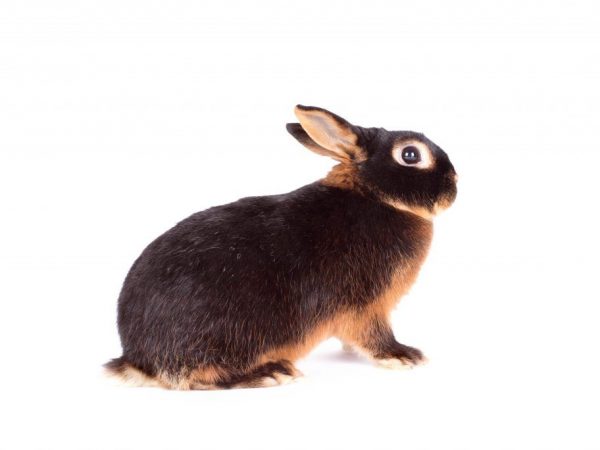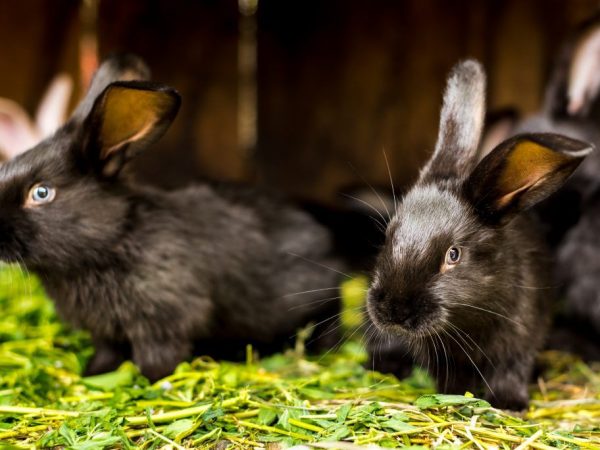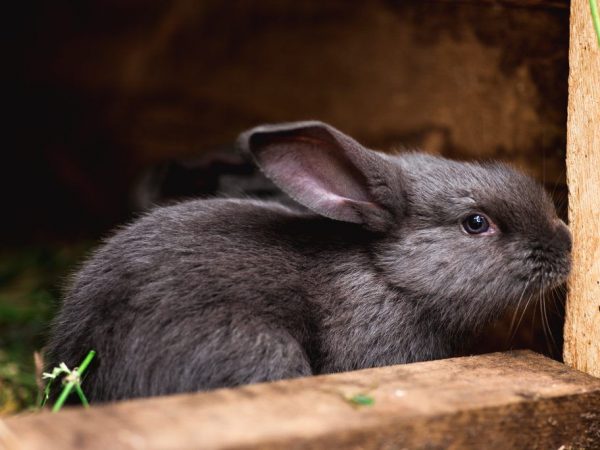Black-brown rabbit
The black-brown rabbit is a special breed of farmer eared. It is good for growing in continental climates.

Characteristics of the black-brown rabbit breed
These eared ears love warmth, a large amount of greenery, but at the same time they are undemanding to care for. Their popularity is primarily due to their good fertility rates and high survival rates.
Distinctive features
Breed advantages:
- resistance to wind gusts and low temperature indicators;
- high percentage of fertility;
- decorativeness of fur wool, its good density;
- effective productivity;
- caring rabbits;
- rapid weight gain with effective assimilation of the feed base.
The character of the animal is peculiar, although it accepts people, but it does not go to contact communication, therefore it is not recommended to keep it as a pet. Black-brown rabbits are suitable for obtaining dietary meat and skins with beautiful fur pile.
The history of the breed
The black-brown rabbit is the result of the selection process.
In the process of breeding this species, breeders wanted to get a stable specimen that would be bred in the territory of the former USSR. At that time, scientists paid attention to the strength of the skin, as well as its use without staining. The breed was bred by crossing the reproductive form.
The breeding process was launched in 1942, and the result was achieved in 1948. In the same period, the standards of the new breed line were defined and established. Rabbit breeders strove to maintain both a high level of density of fur skins (24 thousand hairs per 1 sq. Cm) and a black-brown shade.
Breed standard
Black-brown rabbits are included in the group of large-sized species. Their description is as follows:
- average weight - 5 kg, males are able to reach 7 kg;
- powerful torso, wide thoracic and dorsal regions;
- proportional head sizes, well-visualized under-chest part of the body;
- long front and hind limbs;
- well-developed muscular system;
- the fur is dense, dense, of medium length;
- blue undercoat with a characteristic light shade in the central part and darkening towards the edges;
- due to the scattered growth of guard hairs, the back of the animal is slightly darker in color than the sides of the body.

Features of the breed standard
The breed standard of black-brown rabbits is distinguished by the original color and the correct structure of the undercoat. Also, the rabbit should have a large skeleton and rounded croup.
The black-brown rabbit breed is characterized by the presence of long ears (up to 18 cm), a long body (from 60 to 62 cm), and the girth behind the shoulder blades is about 37 cm.
Description of vices:
- poorly developed skeletal system;
- short, less than 50 cm body;
- the presence of a hump;
- narrow chest (less than 25 cm);
- chopped off croup;
- the presence of clubfoot;
- crookedness and thinness of the limbs;
- at the age of 8 months, a young black-brown rabbit weighs less than 3 kg, and an adult animal weighs less than 4 kg;
- the presence of bundle-shaped guard hairs of a white shade;
- the presence of hairy gray hair;
- the rarity of fur wool;
- color of light shades.
Feeding
This breed needs a full-fledged diet, which includes proteins, carbohydrates, vitamin and mineral complexes. In order for the skeletal part of the body to develop correctly and quickly, it is necessary to add phosphorus-calcium components to the feed, which are contained in meat and bone and fish meal.
Animals are not very demanding on nutrition and can gain body weight when fed with cereals without the use of feed additives. To obtain meat products, it is recommended to provide animals with high-quality and concentrated combined feed. No special feeding is required to obtain the skin.
In summer, it is recommended to give rabbits:
- green plant crops;
- fruit;
- succulent herbaceous plants;
- fresh root vegetables;
- vegetables.
With extreme care, they feed on beets, both fodder and red, as well as cabbage. Before adding these products to the feed, they must be boiled.
In the winter, the animals eat hay that has been prepared in advance in the spring and summer. In order to avoid infection of the oral cavity, woody twigs should be added to food.
Also, rabbits should have constant access to clean water. In the spring, animals should be gradually transferred from dry feed to fresh by reducing dry and increasing the amount of fresh grasses.
Content
In breeding, scientists relied on characteristics such as a high level of productivity and an increased maternal instinct. For one okrol, the female is able to bring at least 7 cubs, mostly 10-12 rabbits. Rabbit mothers do not get mastitis, so babies are always fed and well-fed. The birth weight of the rabbits is 80 g, closer to the age of 3 months, the rabbit gains up to 2.5 kg. This type of rabbit is early maturing, is characterized by rapid weight gain and fleshiness.
The fur undercoat plays a good protective function in the fight against unfavorable climatic conditions, so these animals are often kept outdoors, as they can withstand even the most severe frosty days.

Keeping black-brown rabbits
A problem in breeding is the small number of rabbits of various breeding breed lines. Babies show their breed qualities very late, and therefore early culling should be carried out quite scrupulously.
A black-brown rabbit up to 5 months of age looks angular, as the skeletal system develops rapidly. Closer to 4 months of age, the skeleton begins to round slightly. The quality of the fur is determined only after the second shedding period.
It is necessary to keep pets in medium-sized cages, since animals are relatively large, and in a normal-sized cage they will not feel very comfortable.
In the middle of the cage itself, shelves should be equipped where the rabbits could rest. Given the cleanliness of rabbits, the cages should be cleaned often, at least 3 times a week, because cleanliness is an effective preventive measure against most diseases.
Tips for choosing an animal
You can buy a purebred animal only from rabbit breeders who are seriously engaged in breeding. The black-brown rabbit is completely black at birth, so at this age it is very difficult to assess its compliance with the standard.
The main thing is to make sure that the animal is healthy, it has a well-developed skeleton, not a hunchbacked silhouette and limbs without curvature. A weak individual will produce the same weak offspring.


